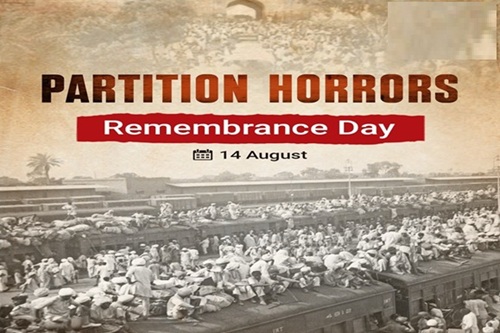Why in news ?
- Every year, 14 August is observed as Partition Horrors Remembrance Day.
- This day is dedicated to paying tribute to the victims of the severe tragedy, mass migration, and communal violence that occurred during the partition of India in 1947.
- This year as well, the nation honors all those who lost their lives, homes, and families, enduring unimaginable suffering during the struggle for independence.

Background
- In 1947, India was divided into two separate nations: India and Pakistan.
- This partition led to the largest human migration and severe communal violence in history.
- Approximately 14–16 million people were forced to leave their homes, and nearly 1–1.5 million people died.
- The partition not only altered political boundaries but also disrupted social, cultural, and human fabrics.
Government Decision
- In 2021, the Government of India decided to observe 14 August every year as Partition Horrors Remembrance Day.
- Objectives:
- To remember the pain and sacrifices of the partition.
- To instill in future generations the message of communal harmony and national unity.
- To pay proper tribute to those who lost their lives or were displaced from their roots.
Significance
- The day reminds us that independence came at the cost not just of political struggle but also immense suffering and sacrifices of millions of ordinary people.
- This remembrance ensures that history’s tragic lessons are not forgotten and helps prevent such divisive circumstances in the future.
- On this day, the nation reaffirms its commitment to peace, brotherhood, and coexistence.
India–Pakistan Partition and the Tragedy
- During the final years of British rule, Hindu–Muslim communal tensions escalated.
- The Muslim League, led by Muhammad Ali Jinnah, intensified the demand for a separate Muslim nation.
- Post-World War II, Britain’s economic and political situation weakened, prompting rapid transfer of power.
- The Mountbatten Plan (3 June 1947) finalized the partition of India.
Partition Process
- Indian Independence Act, 1947:
- Created India and Pakistan as two independent nations.
- Partition date: 15 August 1947.
- Punjab and Bengal were divided under Sir Radcliffe.
- The Radcliffe Line was drawn hastily and secretly, leading to several disputed regions.
Main Causes
- Two-Nation Theory – The Muslim League believed Hindus and Muslims were two distinct nations with different cultures, religions, and lifestyles.
- Communal politics and separate electorates (Acts of 1909, 1919, 1935).
- British “Divide and Rule” policy.
- Mutual distrust between Congress and the Muslim League.
- Political instability post-World War II.
The Tragedy
Partition was not merely a political event but one of the largest human displacements and communal violence episodes in history.
- Mass Migration
- Around 14–16 million people were forced to cross borders.
- Hindus and Sikhs moved to India; some Muslims migrated to Pakistan.
- Refugee camps faced overcrowding, disease, and lack of resources.
- Communal Violence
- Major riots occurred in Punjab, Bengal, Delhi, and Sindh.
- Estimated 1–1.5 million deaths.
- Widespread incidents of rape, abduction, and forced conversions of women.
- Economic and Social Crisis
- People left homes, land, businesses, farms, and industries, becoming refugees.
- Many families were permanently separated.
- Social and cultural fabrics were severely disrupted.
- Beginning of Kashmir Conflict
- Soon after partition, Pakistan attacked Kashmir, leading to the first India–Pakistan war (1947–48).
Long-Term Impact
- Persistent hostility and repeated wars between India and Pakistan (1947, 1965, 1971, 1999).
- Militarization and politics of insecurity in both countries.
- The pain and memories of partition remain alive in literature, films, and collective memory.



